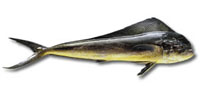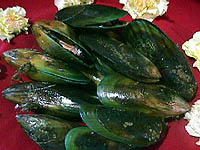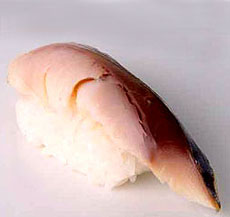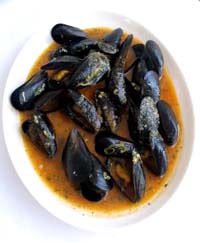|
|
Mahi Mahi is a dolphinfish, but got confused with the swimming mammal dolphin. In order to avoid people thinking they were eating Flipper, it was marketed under its Hawaiian name Mahi Mahi, meaning “strong strong.” A sweet-flavored, firm-textured fish, moderately fat and very flavorful (somewhat similar to swordfish), mahi is local to Florida, Hawaii and other warm waters around the world. It is best prepared simply to enhance its natural flavor—made all the more delicious by its diet of squid, mackerel, shrimp, crab and smaller mahi. They sometimes pursue flying fish by leaping out of the water. |
 Photo courtesy of PacSeafood.com. |
MONKFISH
|
A strange-looking fish that is firm-textured and has delicious meat, often compared to lobster. In Europe, the monkfish has been treasured for many years, but until the later part of the 1970s, American fisherman would dispose of it as trash fish. Americans now keep the monkfish, but only for the meat from the tail, whereas Europeans use the entire fish. It can be prepared using several different cooking methods, such as poaching, roasting, sautéing or grilling. If monkfish is not available, it may be substituted with grouper, tilefish or lobster. If the fish has been properly cooked, the meat will appear opaque, but will still be moist. |
 Illustration courtesy of VSVCape.com. |
MULLET
|
A sort of catchall term, mullet refers to many unrelated fish (particularly goatfish, such as the red mullet), as well as to mullets themselves, of which there are over 100 species. But true mullets, such as the quite common striped and silver mullet, are available in U.S. markets most of the year, depending on the region. Mullets are moderate- to high-fat fish ranging in size from 1/2 to 12 pounds. They have firm, white flesh and a mild, nutty flavor. Mullets are an important food fish around the world and take well to dry or moist heat cooking. |
 Photo courtesy of afcd.gov.hk. |
MOLLUSK
|
Mollusks are one of the two main classifications of shellfish (the other is crustacean). Mollusks cover their soft bodies with a shell of one or more parts, or have developed beyond the need for a shell. There are three classes of mollusks: gastropods, also called univalves, with a single, usually spiral shell (e.g. snail, conch); bivalves, with two shells held together by a muscle (e.g. mussel, oyster); and cephalopods, who have shed their need for external shells (e.g., octopus, squid) but have an internal shell, which is called a pen. |
|
MUSSEL
|
While this bivalve mollusk enjoys enormous popularity in Europe, Americans for the most part tend to ignore them in favor of oysters and clams, but popularity is growing thanks to aquaculture and a good marketing job by mussel producers. There are approximately 17 species of edible mussels that are harvested or cultured worldwide. They all have thin, oblong shells ranging from 1-1/2 to 6 inches in length, and vary in color from blue to green to a yellow-brown. |
 |
|
| New Zealand green-lip mussel. Photos courtesy of PhilsFishMarket.com. |
The most common mussel is the blue mussel found along the Atlantic (including Maine and Prince Edward Island), Pacific and Mediterranean coasts. Live mussels are available year-round, but West Coast mussels can only be had from November through April because of a regional parasite. Canned plain or smoked mussels are also available. While able to be cooked in various ways, they tend to be found alone in a sauce or in the classic bouillabaisse or paella.
Mussel Trivia: 700 years ago, Patrick Walton, a shipwrecked sailor, strung a net between two poles to catch sea birds. He found the mussels growing on the poles, had a good meal of them, and so began mussel farming in France. See also shellfish.
Continue To Page 9: Seafood Terms Beginning With O
Go To The Alphabet Index Above
Lifestyle Direct, Inc. All rights reserved. Images are the copyright of their respective owners.
![]()
© Copyright 2005-2025 Lifestyle Direct, Inc. All rights reserved. All images are copyrighted to their respective owners.






